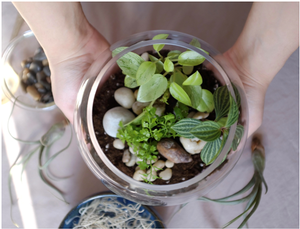Terrariums are stylish glass containers that hold miniature plant worlds. You’ve always seen them dangling delicately in clusters or on window sills. We may not have known them if it hadn’t been for a month, a little soil, and a need for plants in the first place.
Terrarium Singapore is often used as decorative or ornamental items due to its aesthetic qualities. It can be used to quickly add a natural touch to the interior by placing it on shelves or desks in offices or homes. Terrariums may also be used as unusual ornaments on Christmas trees, or packed as presents for loved ones, or even for yourself as a mini treat during the holiday season.

As a self-contained ecosystem, Terrariums are not only easy to manage but also have a variety of health benefits. It purifies the air and raises oxygen levels when used indoors. This is especially important given the high humidity and the air pollution and pollutants we are continuously exposed to in our daily lives. Terrariums will therefore lead to cleaner, more breathable air, making us healthier and happier.
Tips and Tricks of terrarium workshop for Terrarium Planting
- A half an inch of gravel or lava rocks on the ground before applying potting to your terrarium to provide drainage for excess water to trick into
- Choose a clean, transparent container to allow for light to pass in—we suggest a glass container
- Layer half an inch or so of gravel or lava rocks at the bottom of your terrarium before adding potting mix to provide drainage for excess water to trickle down into.
- Remove any air pockets in the potting mix by pressing it flat.
- Arrange your plants inside, leaving enough room for new growth.
Remove any excess soil from the sides of the container or the leaves of your plants with a paintbrush (or toothbrush) until the plants are safely potted.
- Enclosed terrariums, which are normally home to plants that prefer high humidity and moderate sunshine, should be kept out of direct sunlight (a few hours of full sun will easily fry the contents inside)
- Open terrariums are typically used to house plants that prefer dry conditions and bright light, maybe held in bright, direct to indirect light, such as on a windowsill.
- Water directly at the base of the plants or through the potting soil to ensure that the water reaches the root systems.
- Make every effort not to overwater your terrarium—there is no drainage hole for excess water to escape the terrarium, so don’t soak the soil (it should be damp but not sopping wet).
- Remember that adding water to soil is much better than taking it away.
- Allow an enclosed terrarium to breathe every 1-2 weeks by removing the lid or leaving it ajar for up to 24 hours.
- Rotate the terrarium every 1-2 weeks to prevent plants from growing upward and filling in extra space.
Often select plants that grow in similar conditions, such as plants that prefer a similar amount of sunshine, humidity, and water, if you’re mixing plant varieties. Never mixed succulents, preferring hot and dry conditions, with moss, which prefers cool and moist conditions—instead, mix succulents with cacti and moss with ferns.






